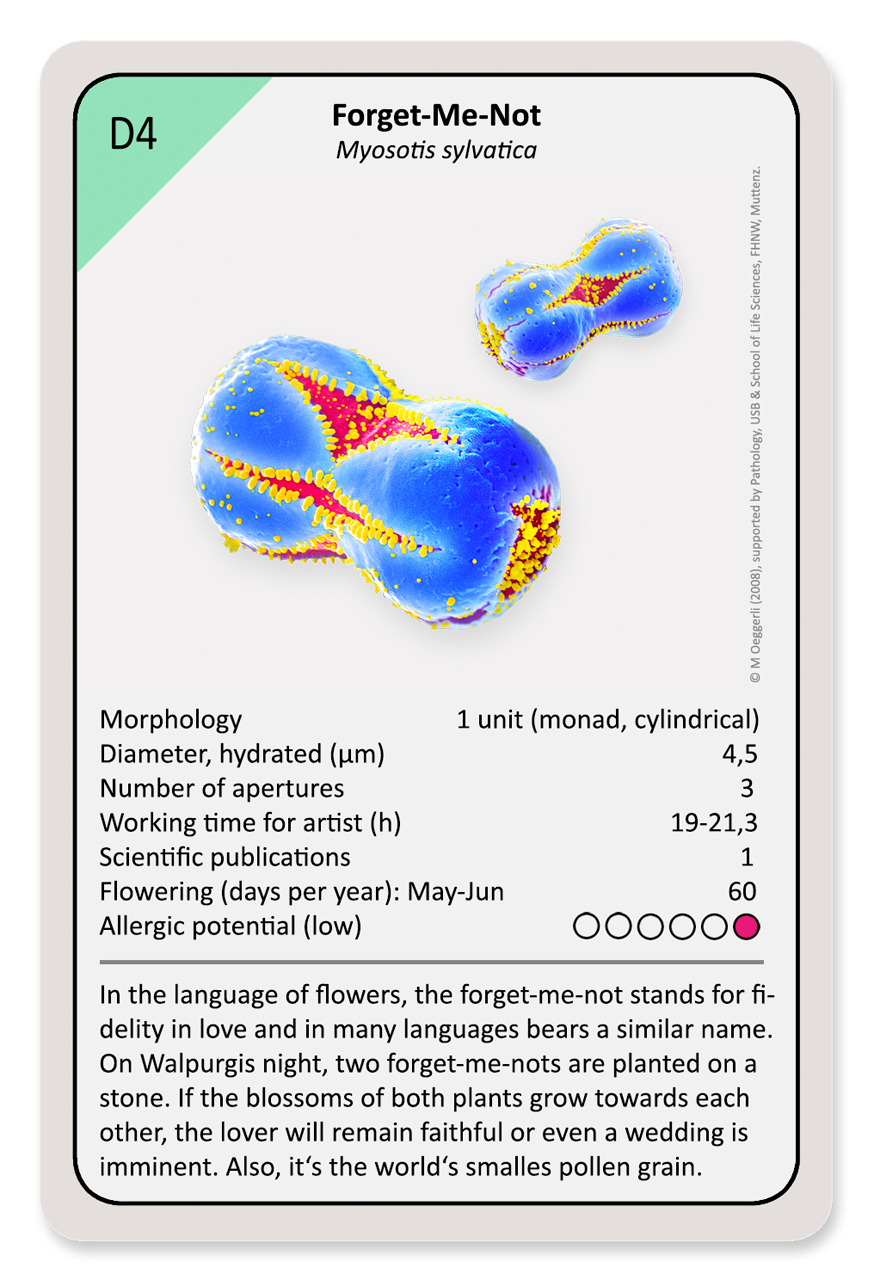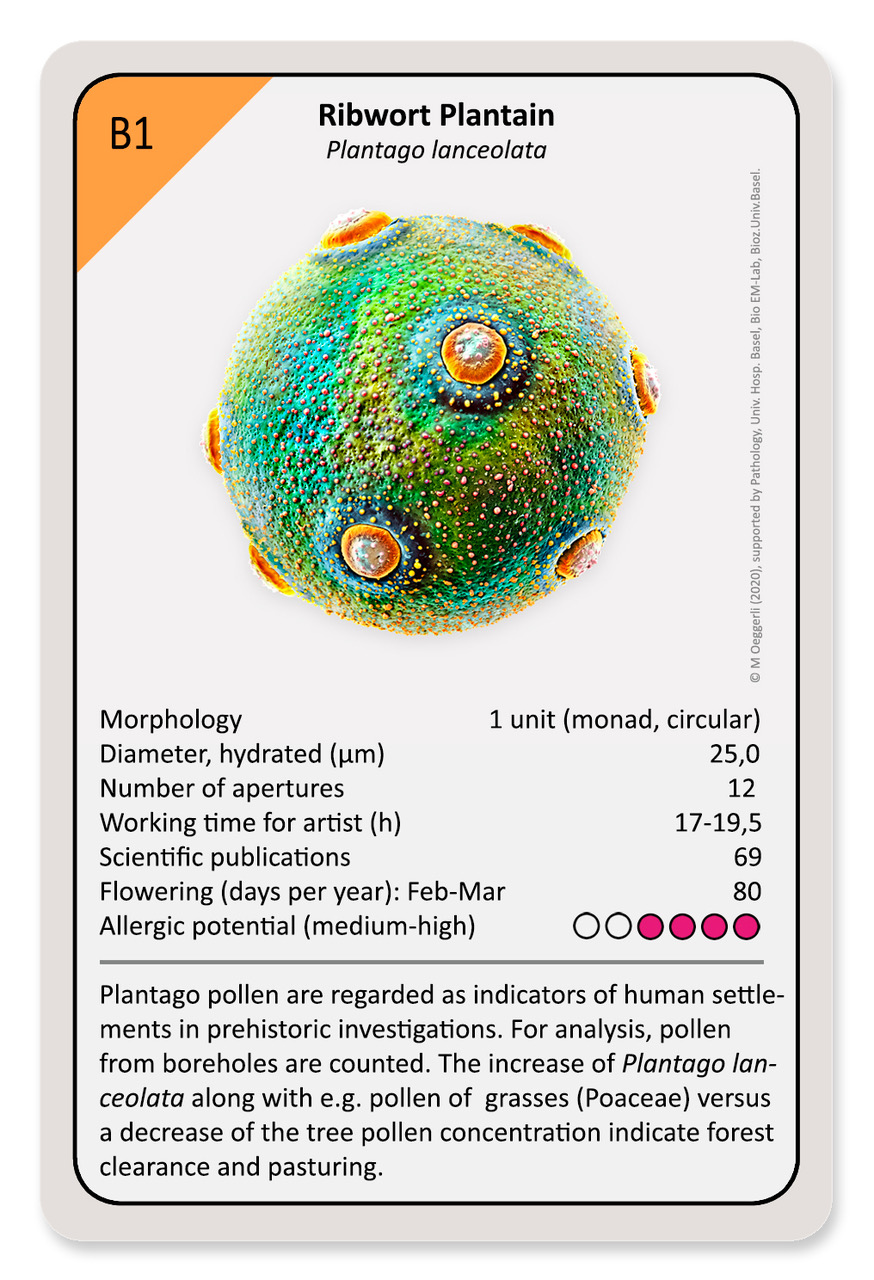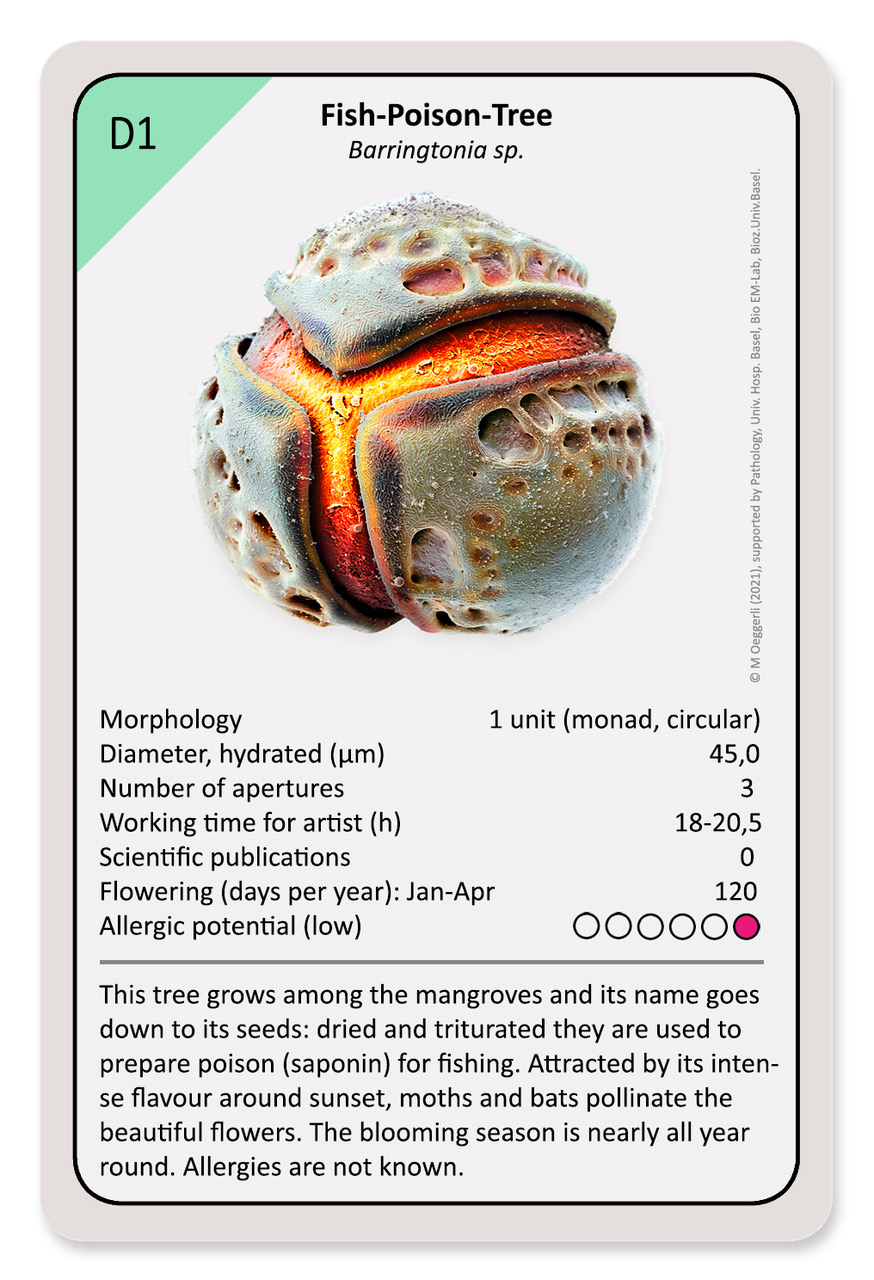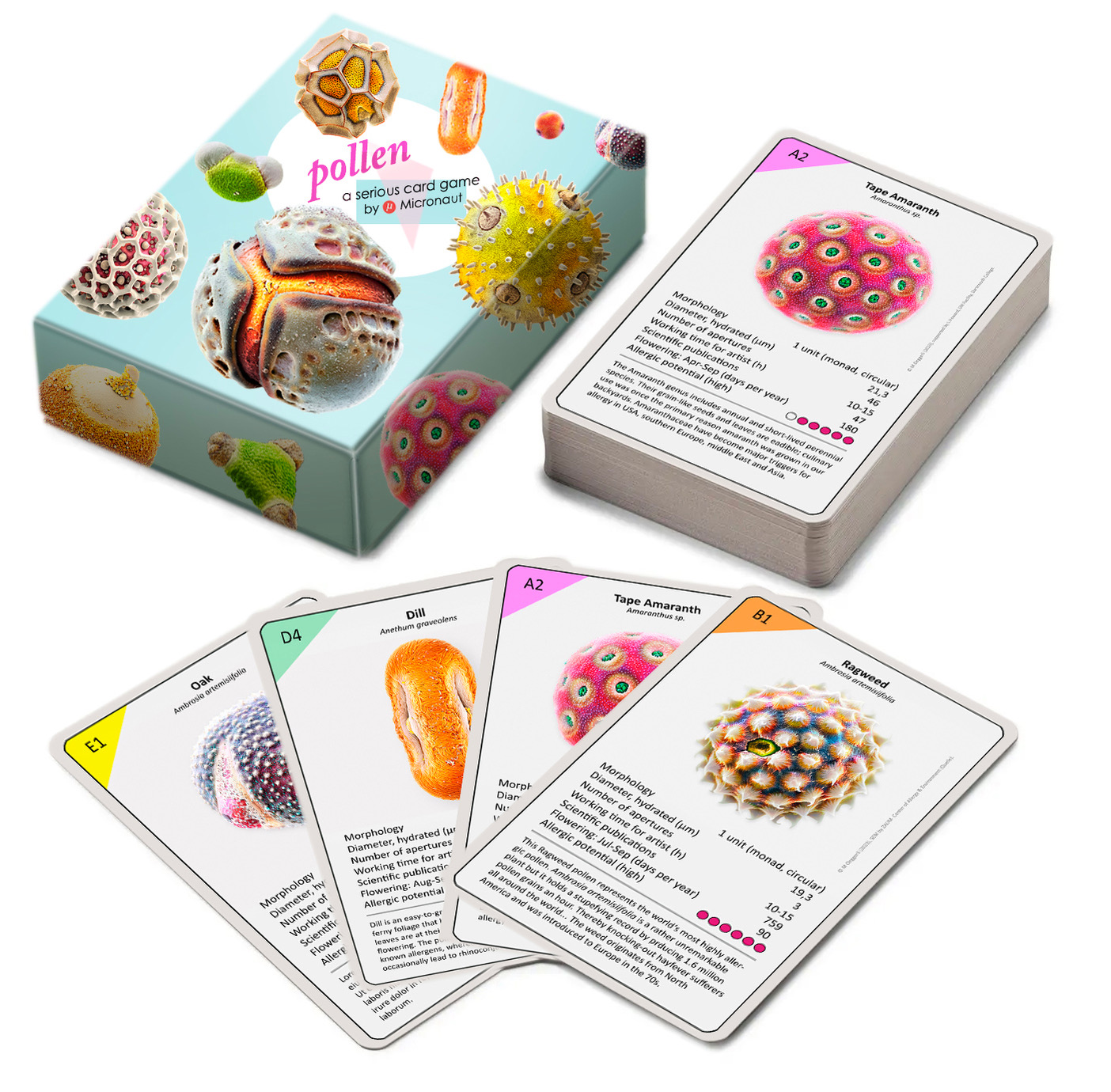Pollen – A serious card game («Quartett»)
For those who seek to playfully explore the world.
With this card game the artist Martin Oeggerli invites you to dive into the beauty of «his» cosmos. A fascinating selection of pollen grains collected from all over the world is waiting for you to be discovered, allowing you to experience the diversity of this earth. Data on the plant and pollen give the nature lover as well as the allergy sufferer playful, interesting and helpful information. All images in this edition are hand-coloured scanning electron micrographs, unique in selection and artistic presentation.
«Through Martin Oeggerli’s exploration of the microcosmos we see new expressions of the beauty in nature that we never imagined»
Todd James, Senior photo editor, National Geographic
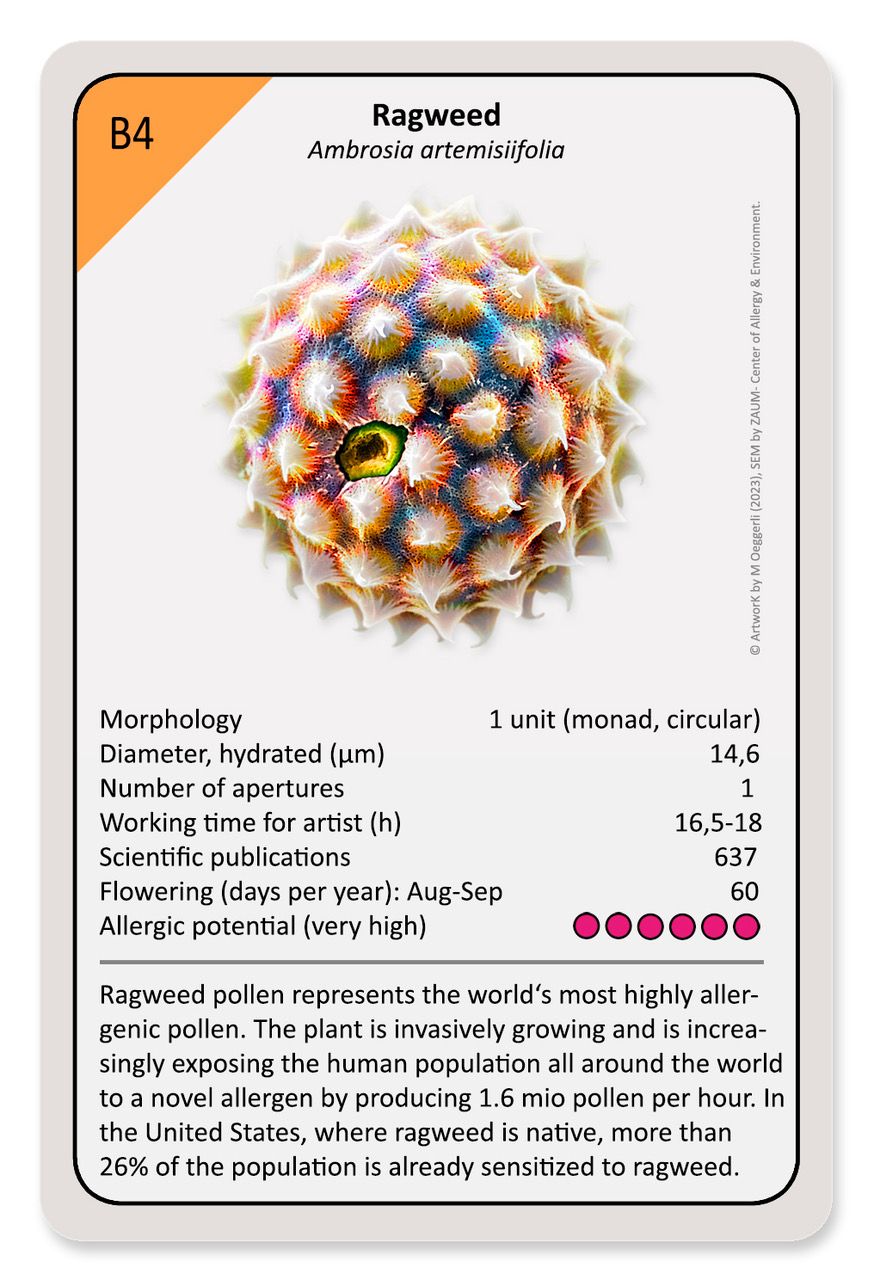
The world’s most allergenic pollen grain: Ragweed pollen
(Ambrosia artemisiifolia)
Mit diesem Quartett lädt Sie der Künstler Martin Oeggerli ein in die Schönheit „seines“ Kosmos einzutauchen. Eine faszinierende Auswahl von Pollen aus aller Welt wartet auf Sie entdeckt zu werden und die Diversität dieser Erde zu erleben. Angaben zur Pflanze und Pollen geben dem Naturliebhaber und dem Allergiker spielerisch interessante und hilfreiche Information. Alle Bilder dieser Edition sind handkolorierte rasterelektronenmikroskopische Aufnahmen, einzigartig in Auswahl und künstlerischen Darstellung.
Order ‹Pollen – a serious card game›: (CHF 30.-), excl. shipping and VAT.
What’s in the box?
- format: 48 big sized (tarot) cards
- available in German or English
- for companies: card backside can be customized for orders from 300 pieces or more
- developed in Switzerland, printed in Germany
information & references
You got the pollen card game and want to know more?
Here are the basic facts about pollen.
Pollen is indispensable to the reproduction of seed-bearing plants (Spermatophyta) in that it represents the male gametophyte.
For the transfer of the «male» pollen grain to the female flower, nature has developed a wide variety of mechanisms. The best known is the story with the bee, i.e. pollination by insects (entomophilous). The flowers of these plants are usually magnificent, attract the corresponding insects very purposefully via colours or bloom, smell/scent and with nutritious nectar. Other plants that are pollinated by birds, mammals or bats for example (zoophilic), have the flowers appropriately enhanced and are also perfectly targeted to the visitor that is preferred. For this, these plants produce little pollen.
Pollen allergy sufferers are mostly interested in plants that transfer pollen by wind (anemophilous), because the majority of allergenic plants are pollinated by wind. The adaptation to wind pollination – to ensure a wide distribution with the wind – determines the morphological characteristics: the pollen of anemophilous plants is small, the openings (apertures) are round and the ornamentation is simple. Some pollen carry wind sacs (e.g. Pinus) to reduce density and make the pollen lighter. However, the most important distinguishing feature for the allergy sufferer of these anemophilous plants is: they usually produce millions and millions of pollen grains, which they release into the air. If the pollen now also has an antigenic component (protein), it fulfills all the requirements for triggering an allergy. On contact with the mucous membrane, the pollen is in most cases hydrated by the moisture of the mucous membrane and the allergen is released.
Which pollens predominate as triggers for allergies in each case depends on many factors. In the past, it was quite easy to assign potentially allergenic pollen in Europe to climatic zones. For example, birch was a more frequent allergy trigger in arctic regions, while grasses, mugwort and ragweed dominated in eastern Europe. However, the so-called pollen map of Europe is constantly changing due to cultural factors (e.g. importation of plants known as allergenic in other parts of the world for private gardens and urban parks), a basically larger international distribution (e.g. ragweed colonisation in France, northern Italy, Austria, Hungary, etc.) and climate change. Strong (local) weather fluctuations bring forward, delay or extend the flowering period and thus the pollen release. As a result, certain potentially allergenic plants sometimes bloom at the same time as other plants – possibly newly introduced species to this region – and lead to multiple sensitizations, which have not yet occurred so frequently in this combination.
Some pollens are known to cross-react with certain fruits/nuts. When a person reacts to pollen and then consumes the corresponding foods, an allergic reaction occurs, also known as Oral Allergy Syndrome (OAS). People affected by OAS can usually eat the same fruits or vegetables in cooked form because the proteins are distorted during the heating process, and the immune system no longer recognizes the food.
But enough of the whole allergy topic! The science, which also describes the pollen analysis (the palynology) is a wide and very interesting field. Recent as well as fossil pollen allow many conclusions in the evaluation of e.g. the climate development, archaeology, criminology…
We are glad if we could once again arouse interest in the pictures and stories of the very tiny things!
Where did we research the information on the specific card texts?
Much of the information is the knowledge of a passionate gardener and trained biologist. Of course, this knowledge is never enough and we did also research the latest scientific publications and received huge support from experts in the field of pollen and allergiology.
Acknowledgements
The Micronaut team is very grateful to Prof. Dr. med. Peter Schmid-Grendelmeier, Head Allergy Unit & Senior Lecturer University Hospital Zurich, and Dr. Bernard Clot, Federal office of meteorology and climatology MeteoSwiss. In addition our special thanks go to the never tired card game-team, including Dr. Annika Meyer, Jenny Hayes, and Dr. Anne Thielbeer. Furthermore, we would like to thank the following persons and entities for their invaluable support, to breed and collect samples, to create or use existent images, or use high-tech equipment in the lab: Edith Zemp and Dr. Bruno Erny, Botanical Garden Basel, Prof. Dr. Beate Alberternst and Dr. Jeroen Buters, Direktor ZAUM Technische Universität München, Dr. Mohammed Chami and Dr. Kenneth N Goldie, Bio-EM Lab, University Basel, SNI, Biozentrum, University Basel, Prof. Dr. Falko Schlottig, Marcus Waser, Theo Bühler, School of Life Sciences, FHNW, Muttenz, the entire leadership and team -now and over the past 18 years- at the Pathology, University Hospital Basel, as well as Prof. Dr. Henning Stahlberg, C-CINA, University Basel, and my palynology experts from Vienna: Mag. Dr. Silvia Ulrich and Dr. Heidemarie Halbritter, Prof. Dr. Monika Weber, Dr. Ralf Buchner, and Dr. Matthias Svojtka, Department of Botany and Biodiversity Research, University Vienna, in addition Louisa Howard and Dr. Maxime J. Guinel de France, Dartmouth College, and last but not least – my dear friends Edith and Hermann Zgraggen, PTU GmbH, which helped me so much to stay in the race very early on in my career – our collaboration actually lead to my first pollen image!
Sources & References:
Sessile oak – Quercus petraea– Steineiche/Traubeneiche:
Ferreira F, Gadermaier G, WallnerM. Tree pollen allergens. Global Atlas of Allergy (2014), pp.18-21
Ragweed – Ambrosia artemisiifolia – Beifussblättriges Traubenkraut
Arbes SJ, Gergen PJ, Elliott L, Zeldin DC. Prevalences of positive skin test responses to 10 common allergens in the US population: results from the Third National Health and Nutrition Examination Survey. J Allergy Clin Immunol. 2005;116:377–383
Tape Amaranth – Amaranthus sp.- Amaranth
Dramburg, S, Hilger C, Santos AF, de Las Vecillas L, Aalberse RC, Acevedo N et al (2023). EAACI Molecular Allergology User’s Guide 2.0. Pediatric Allergy and Immunology, 34 (Suppl 28), doi.org/10.1111/pai.13854
Angel’s trumpet – Brugmansia sanguinea– Engelstrompete
www.britannica.com/plant/angels-trumpet
Myrtle Wattle or Red-stemmed Wattle – Acacia myrtifolia – Schirmakazie
Shamsbiranvand MH, Khodadadi A, Assarehzadegan MA, Borsi SH, Amini A. Immunochemical characterization of acacia pollen allergens and evaluation of cross-reactivity pattern with the common allergenic pollens. J Allergy (Cairo) 2014: 409056
Black Alder – Alnus glutinosa– Erle
Asam C, Hofer H, Wolf M, Aglas L, Wallner M.Tree pollen allergens—an update from a molecular perspective.Allergy. 2015 Oct; 70(10): 1201–1211. doi.org 10.1111/all.12696
Birch – Betula humilis– Birke
http://www.immunocapexplorer.com/de/molekulare-allergologie/birkenpollen-allergie (Thermo Fisher Diagnostics GmbH).
https://allergiecheck.de/pages/birkenpollenallergie (ALK-Abelló Arzneimittel GmbH).
Pumpkin – Cucurbita pepo-Kürbis
Michael G. Diversity and Classification of flowering Plants (second edition), 2010, p 275-448.
Globe thistle – Echinops exaltatus– Kugeldi
Denisow-Pietrzyk M, Pietrzyk Ł, Denisow B. Asteraceae species as potential environmental factors of allergy. Environ Sci Pollut Res Int. 2019 Mar;26(7):6290-6300. doi.org: 10.1007/s11356-019-04146-w
Erica shrub – Erica perspicua– Erica
Barnard P, Coetzee A, Geerts S, Pauw A. Pink flower preference in sunbirds does not translate into plant fitness differences in a polymorphic Erica species. Evolutionary Ecology
2014/05/01, doi.org:10.1007/s10682-014-9693-z
Snowdrop – Galanthus nivalis– Schneeglöckchen
https://www.bienenjournal.de/imkerpraxis/ratgeber/fruehblueher-fuer-bienen
Amaranth – Gomphrena globosa– Kugelamaranth
Jiang Y, Zhao N, Wang F, Chen F. Emissions and Regulation of Volatile Chemicals from Globe Amaranth Flowers. Journal of the American Society for Horticultural Science2010,. Volume 136: Issue 1 p16–22. doi.org/10.21273/JASHS.136.1.16
Silky needle bush – Hakea tenuifolia– Silberbaum
Ladd P, Bowen B. Pollen release in the Proteaceae. Plant Systematics and Evolution, Sep 2020, 306(5):81. doi.org/10.1007/s00606-020-01707-2
Firecracker Flower – Justizia rizzinii– Jakobinie
Cronk Q, Ojeda I, Bird-pollinated flowers in an evolutionary and molecular context. Journal of Experimental Botany, 2008, Vol. 59, No. 4, pp. 715–727, doi.org/10.1093/jxb/ern009
Water Water lettuce – Pistia stratiotes (Araceae)- Wassersalat
Bröderbauer D, Diaz A, Weber A. Reconstructing the origin and elaboration of insect-trapping inflorescences in the Araceae, Am J Bot. 2012 Oct; 99(10): 1666–1679. doi.org:10.3732/ajb.1200274
Ribwort Plantain – Plantago lanceolata– Spitzwegerich
Bartley D, Morgan AV. The Palynological record of the King´s Pool, Stafford, England. 1990 New Phythol. 116, 177-194
Sweet Pea Bush – Polygala grandiflora– Kreuzblume/-busch
van der Kooi CJ, Vallejo-Marín M, Leonhardt SD, Mutualisms and (A)symmetry in Plant–Pollinator Interactions, Current Biology, 2021, Volume 31, Issue 2, p 91-99
Silverleaf tree – Proteaceae (evtl. Leucospermum sp.)– Silberbaum
Johnson CM, Pauw A. Adaptation for rodent pollination inLeucospermum arenarium (Proteaceae) despite rapid pollen loss during grooming. Ann Bot. 2014 May; 113(6): 931–938
Bromeliad– Wittrockia cyanthiformis – Bromeliengewächs
Nievola, CC, Kanashiro S., Tamaki V., Guardia MC, Suzuki RM, Costa JP, Baptista W, Cachenco MV, Shidomi Y, Santos Junior, NA. dos. (2022). Simultaneous relocation strategy of bromeliads as epiphytes or terricolous in the Montane Dense Ombrophilous Forest of Parque Estadual da Cantareira, São Paulo State, Brazil. In SciELO Preprints. doi.org/10.1590/2236-8906-05/2022
Cymbopetalum aequale
Tsou C, Fu Y. Octad pollen formation in Cymbopetalum (Annonaceae): The binding mechanism. Plant Systematics and Evolution. DEC 2007,263, pages 13–23.
Military Orchid – Orchis miltaris– Helm-Knabenkraut
Henneresse T, Tyteca D. Insect Visitors and Potential Pollinators of Orchis militaris (Orchidaceae) in Southern Belgium. J Insect Sci. 2016; 16(1): 104. doi.org 10.1093/jisesa/iew088
References used for the general information section:
D’Amato G., Cecchi L, Bonini S, nunes C, Annesi-Maesano, Behrendt H, Liccardi G, Popov T, VanCauwenberge P. Allergic pollen and pollen allergy in Europe, 2007.
https://doi.org/10.1111/j.1398-9995.2007.01393.x
Diethart B, Sam S, Weber M,
Walls of allergenic pollen: Special reference to the endexine, 2007, Grana, 46:3, 164-175, doi: 10.1080/00173130701472181
American College of Allergy, Asthma and Immunology (acai.org), website visit August 2023.
https://acaai.org/allergies/allergic-conditions/food/pollen-food-allergy-syndrome/
Ianovici N. The principal airborne and allergenic pollen species in Timisoara. Annals of West University of Timişoara, ser. Biology, vol.X, 2007, pp 11-26
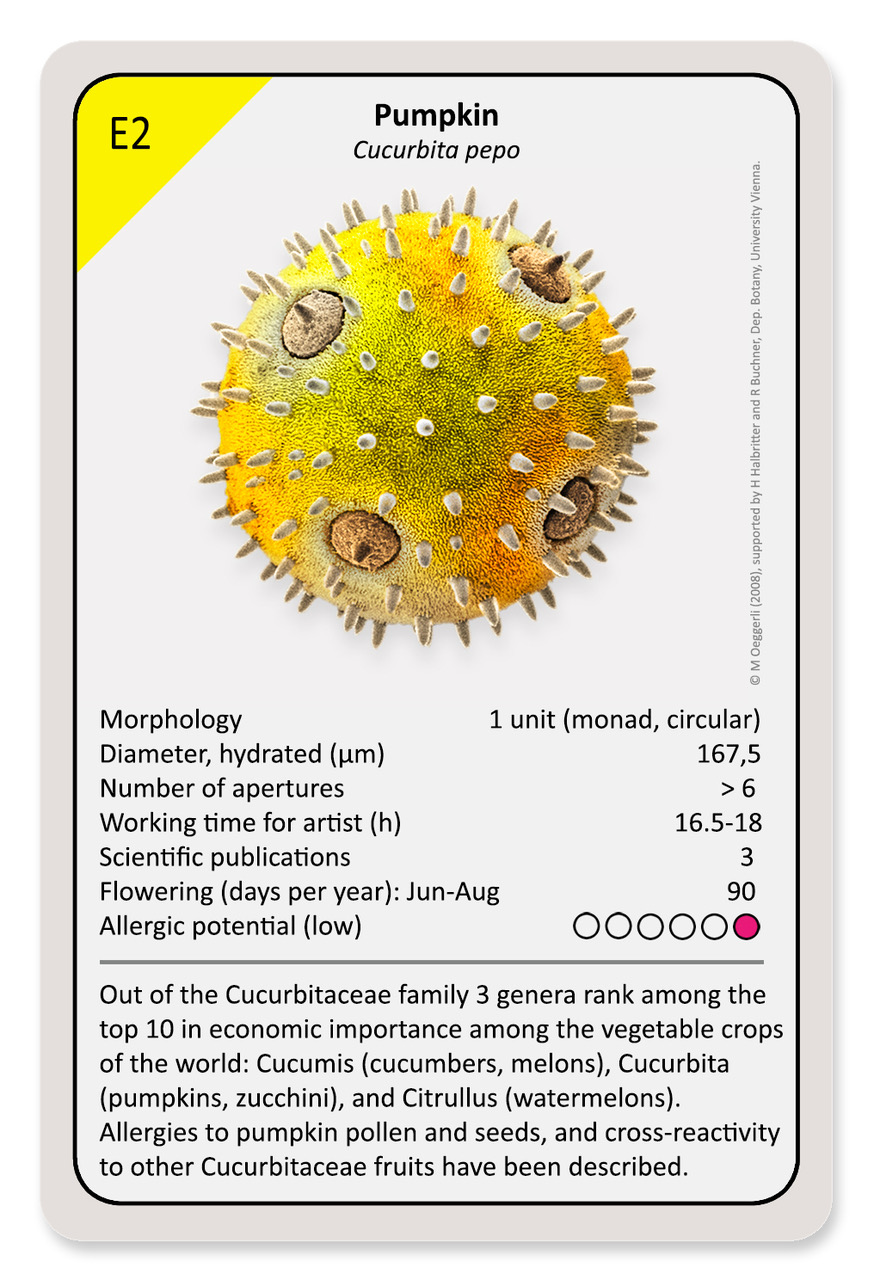
The world’s largest pollen grain: Pumpkin (Cucurbita pepo
